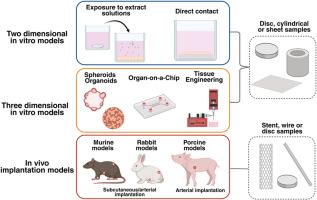评价生物可吸收金属心血管支架生物相容性的临床前研究模型:比较综述
IF 18
1区 医学
Q1 ENGINEERING, BIOMEDICAL
引用次数: 0
摘要
在冠状动脉成形术后,心血管支架通过缓解血管阻塞和提供结构支持而被广泛应用于动脉粥样硬化的治疗。生物可吸收金属支架是传统耐腐蚀支架的一种很有前途的替代方案,后者与支架内再狭窄和血栓形成等晚期并发症有关。由于支架材料和设计的多样性,在临床转化之前,在相关临床前模型中严格评估其与血管环境的相互作用是必不可少的。然而,目前的研究采用高度可变的体外细胞系统、体内动物模型和实验分析来评估生物相容性,因此很难对候选设计得出明确的结论。本综述概述了生物可吸收金属支架的现状,批判性地检查了文献和国际指南中描述的临床前模型的优势和局限性,并为指导这一快速发展领域的未来研究提供了建议。本文章由计算机程序翻译,如有差异,请以英文原文为准。

Preclinical research models for evaluating the biocompatibility of bioresorbable metallic cardiovascular stents: A comparative review
Cardiovascular stents are widely used to treat atherosclerosis by relieving vascular obstruction and providing structural support after coronary angioplasty. Bioresorbable metallic stents represent a promising alternative to conventional corrosion-resistant stents, which are linked to late-stage complications such as in-stent restenosis and thrombosis. Due to the diversity of stent materials and designs, rigorous evaluation of their interactions with the vascular environment in relevant preclinical models is essential before clinical translation. However, current studies employ highly variable in vitro cell systems, in vivo animal models, and experimental assays to assess biocompatibility, making it difficult to draw definitive conclusions about candidate designs. This review outlines the current landscape of bioresorbable metallic stents, critically examines the strengths and limitations of preclinical models described in the literature and in international guidelines, and provides recommendations to guide future research in this rapidly evolving field.
求助全文
通过发布文献求助,成功后即可免费获取论文全文。
去求助
来源期刊

Bioactive Materials
Biochemistry, Genetics and Molecular Biology-Biotechnology
CiteScore
28.00
自引率
6.30%
发文量
436
审稿时长
20 days
期刊介绍:
Bioactive Materials is a peer-reviewed research publication that focuses on advancements in bioactive materials. The journal accepts research papers, reviews, and rapid communications in the field of next-generation biomaterials that interact with cells, tissues, and organs in various living organisms.
The primary goal of Bioactive Materials is to promote the science and engineering of biomaterials that exhibit adaptiveness to the biological environment. These materials are specifically designed to stimulate or direct appropriate cell and tissue responses or regulate interactions with microorganisms.
The journal covers a wide range of bioactive materials, including those that are engineered or designed in terms of their physical form (e.g. particulate, fiber), topology (e.g. porosity, surface roughness), or dimensions (ranging from macro to nano-scales). Contributions are sought from the following categories of bioactive materials:
Bioactive metals and alloys
Bioactive inorganics: ceramics, glasses, and carbon-based materials
Bioactive polymers and gels
Bioactive materials derived from natural sources
Bioactive composites
These materials find applications in human and veterinary medicine, such as implants, tissue engineering scaffolds, cell/drug/gene carriers, as well as imaging and sensing devices.
 求助内容:
求助内容: 应助结果提醒方式:
应助结果提醒方式:


